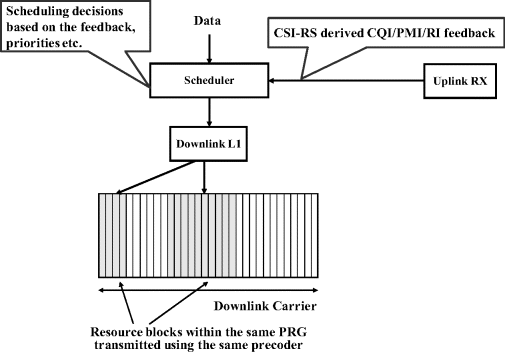6.3 Protocol Impact from Downlink MIMO Enhancements
The downlink MIMO operation is visible mainly in the physical layer, however, the MAC layer scheduler is takes part in deciding the connection with the feedback received in the uplink direction, when a user should be scheduled, and what kind of rank (number of parallel MIMO streams) should be used, or whether the conditions would be proper for a Multiuser MIMO (MU-MIMO) operation. MAC layer operation in connection with downlink MIMO is illustrated in Figure 6.2.
Figure 6.2 Downlink MIMO feedback for an eNodeB scheduler.

The UE will derive the feedback from the CSI-RS, which is discussed more in Section 6.4. Then the eNodeB scheduler will determine which user to schedule based on the feedback received as well as the user priority, buffer status and other vendor-specific criteria. If multiple Release 10 features are available, such as carrier aggregation, the eNodeB scheduler needs to consider the situation across multiple carriers where a particular user is to be scheduled and with what kind of MIMO transmission is to be used.
There are several new parameters to configure in the RRC signalling for Release 10 downlink MIMO operation, including the CSI-RS configuration and what kind of feedback to provide. For the mobility measurements and actual procedures there are no changes due to the introduction of MIMO, as the mobility measurements ...
Get LTE Advanced: 3GPP Solution for IMT-Advanced now with the O’Reilly learning platform.
O’Reilly members experience books, live events, courses curated by job role, and more from O’Reilly and nearly 200 top publishers.

